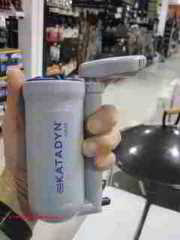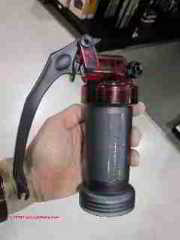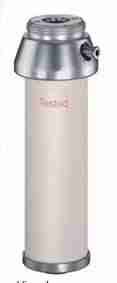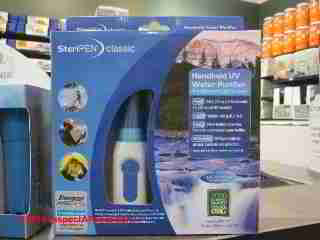 Select & Use a Filter to Purify or Sterilize Drinking Water
Select & Use a Filter to Purify or Sterilize Drinking Water
Portable use, camping, & emergency water filters
- POST a QUESTION or COMMENT about using filters to purify drinking water; what types of portable or temporary water purifying filters are available; what types of more permanent water purifying filters are installed?
Guide to water purifying filters:
Here we explain and help choose among the types of portable water purification filters that can be used to sterilize water for drinking purposes when traveling, camping, and in emergencies when the normal water supply is not available or is not sanitary.
InspectAPedia tolerates no conflicts of interest. We have no relationship with advertisers, products, or services discussed at this website.
Guide to Use of Filters for Drinking Water Purification
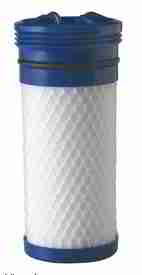 The best procedure if you don't know much about the water condition is to filter it before and after it is treated with bleach, chlorine, iodine, or other sterilization methods.
The best procedure if you don't know much about the water condition is to filter it before and after it is treated with bleach, chlorine, iodine, or other sterilization methods.
This article series outlines methods to purify or sanitize drinking water in an emergency following a disaster such as an earthquake, flood, or hurricane.
[Click to enlarge any image]
A companion article, DRINKING WATER EMERGENCY SOURCES,describes possible sources of drinking water that may be useful in emergency conditions.
See WATER TREATMENT EQUIPMENT CHOICES for details on other water treatment options.
The good news is that there are types of water filters and water filtration systems that can treat water containing various microbes including bacteria, Giardia, and Cryptosporidium cysts, as we discuss just below.
If you are looking for information on home water filters to be installed on plumbing systems in regular use, such as filters used to remove dirt, silt, sediment, iron, and odors from well water,
Ceramic water purifying filters for Water Purification Treatment
Purifying filters use materials such as ceramic filters which have extremely fine pores to filter out harmful bacteria and protozoa. Examples of portable ceramic water filters include the Katadyn® ceramic water filter, Hiker Pro Micro Filter (also from Katadyn), and ExsStream ceramic water filter.
Our portable, hand-operated pump-type water filters shown below include the Katadyn® Hiker microfilter (below left) and the Minworks® EX Microfilter.
Some more recent single or multi-stage microfiber water filters have a very high gallon capacity and most models can simply be cleaned and re-used.
- For example, The Katadyn Combi filter (www.rei.com) uses a combination of a silver-impregnated ceramic filter element and an activated-carbon cartridge to both filter and improve the taste of drinking water in a portable device intended for backpackers.
Portable water filters
all include a pump, usually a manual or hand pump, which forces water through a very fine ceramic filter cartridge, delivering a clean, if slow stream of potable drinking water. Some portable water filters include a container into which water is poured, then pumped out.
Note on Portable Water Filter Cartridge Types:
There are several types of filter cartridge designs, among which in our OPINION the most significant distinction is between fiberglass/paper/charcoal type filters and ceramic filters. The latter, ceramics, can be expected to have a longer use-life and can be cleaned and restored in the field.
If you care, be sure to check the type of filter used in the specific model of portable water filter you are considering, as several manufacturers offer more than one filter type across their model line.
The Katadyn Hiker water filter (above left) produces 1 liter of water per minute (depending on how fast you operate the pump handle), or a measure we like better, it produces one liter of filtered water in 48 pump strokes. The filter used includes an activated carbon core that can remove some tastes and odors from water as well.
The pump accepts water in from a fitting at the device bottom, and pushes filtered water out from a fitting at the filter top. Plastic tubing to attach to these ports, along with a filter cartridge and a "pre-filter" and carrying bag are provided by Katadyn.
A replacement filter for the Katadyn Hiker/Hiker PRO, and Base Camp filter models is shown at left.
The Katadyn Hiker water filter uses a 0.3 micron pleated glassfiber (fiberglass) filter with an activated charcoal core to remove bacteria, cysts, and sediment (Klebsiella terrigena, Giardia, and Cryptosporidium). One filter is rated for up to 750 liters of water (250 gallons), or less, depending on the clarity of the starting water being filtered. The device weighs 11 ounces and is 6.5" x 3". without including the tubing or accessories.
Katadyn produces three groups of water filter products: an Endurance Series (higher capacity, extreme use conditions, can handle highly turbid (murky) water), Backcountry series (1-2 persons, suitable for clear or slightly turbid water), and the Ultralight Series product described above, intended for single person use and a clear water source outdoors or while traveling and staying at hotels that may provide a questionable water supply.
The Miniworks® EX Microfilter water filter
and pump system produced by MSR (Cascade Designs, Inc.) a camping equipment manufacturer, is built around a field-maintainable ceramic filter element that can be washed in the field for full filter recovery. [See our comments about larger ceramic water filters, below.]
The filter system includes a block of activated charcoal to assist in removing water odors and some chemicals (and thus water taste). Plastic tubing (a hose float), scrubbing pad, and storage sack are provided by the producer.
Like Katadyn, MSR produces several product ranges of water purification systems including their Expedition water treatment system (MIOX® purifier, municipal-grade water purification, no pumping, maintenance, or iodine; MiniWorks EX microfilter [discussed above], field maintainable, carbon/ceramic filter element that can be field-renewed), their Fast & Light water treatment system, and their Basecamp water treatment system.
Other, heavier, larger ceramic water filter systems such as a model we used during weeks of rafting down the Colorado River, are intended to deliver a larger quantity of potable water: these models can be inserted into a larger container of water. The hand pump draws water out of the container, through the filter, and then delivers it out of a spout or tube into a clean container for drinking or other uses.
The photo at left (courtesy Katadyn) shows a replacement ceramic filter element for a Katadyn Pocket filter system.
In the event that the municipal water supply system is working after a hurricane, flood, or other disaster, companies like Katadyn also produce water filters that can be attached to a faucet and are operated by system water pressure.
Doulton® is a company in the U.K. with branches in the U.S. that produces a wide range of ceramic water filtration equipment including point of use filters (POU filters) and filters that can operate by gravity rather than requiring a pump. A gravity operated ceramic water filter would be an effective means of sanitizing water from a rooftop water cistern.
Small portable water filters are produced by Pure Water 2Go®, and MSR MiniWorks® Water Filter. Small and larger capacity portable ceramic water filters are available from many sources including camping equipment suppliers and water treatment equipment suppliers such as Crystal Clear Supply.
Field Experience & Community Use of Ceramic Water Filters in Mexico
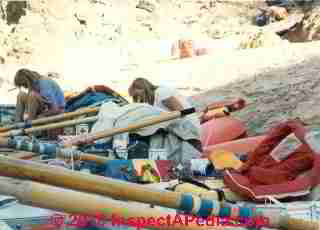 Additional details about ceramic water filters.
Additional details about ceramic water filters.
Ceramic water filters have been around for decades. We first used one during a raft trip down the Colorado river in the 1980's. There the raft crew used a large ceramic filter to produce safe, potable water right out of a 5-gallon bucket of river-water. The only maintenance required was occasional soft-brush scrubbing of silt or debris from the filter's exterior.
Discussed more-recently as an inexpensive way to provide potable water to rural communities in Mexico, Caminos de Agua has come up with an elegantly simple combination of a ceramic water filter with a large plastic bottle widely used to deliver purified drinking water.
The ceramic filter is placed at the outlet of a bottle of water that is in turn placed atop a ceramic or glass carafe water dispenser.
The ceramic water filter described by Caminos de Agua at caminosdeagua.org/ceramic-water-filters seems a good idea - effective at removing contaminates common water supplies including the protozoan cysts that I mentioned to you, though Bielefeldt points out that their performance across models is not consistent.
The life of a good ceramic filter can be many years - its exterior surface needs to be periodically scrubbed.
Research on the effectiveness of ceramic water filters to reduce local diarrhea
- Brown, Joe, Mark D. Sobsey, and Dana Loomis. "Local drinking water filters reduce diarrheal disease in Cambodia: a randomized, controlled trial of the ceramic water purifier." The American journal of tropical medicine and hygiene 79, no. 3 (2008): 394-400.
- Bielefeldt, Angela R., Kate Kowalski, Cherylynn Schilling, Simon Schreier, Amanda Kohler, and R. Scott Summers. "Removal of virus to protozoan sized particles in point-of-use ceramic water filters." Water research 44, no. 5 (2010): 1482-1488.
- Sobsey, Mark D., Christine E. Stauber, Lisa M. Casanova, Joseph M. Brown, and Mark A. Elliott. "Point of use household drinking water filtration: a practical, effective solution for providing sustained access to safe drinking water in the developing world." Environmental science & technology 42, no. 12 (2008): 4261-4267.
The lack of safe water creates a tremendous burden of diarrheal disease and other debilitating, life-threatening illnesses for people in the developing world. Point-of-use (POU) water treatment technology has emerged as an approach that empowers people and communities without access to safe water to improve water quality by treating it in the home.
Several POU technologies are available, but, except for boiling, none have achieved sustained, large-scale use. Sustained use is essential if household water treatment technology (HWT) is to provide continued protection, but it is difficult to achieve.
The most effective, widely promoted and used POU HWTs are critically examined according to specified criteria for performance and sustainability. Ceramic and biosand household water filters are identified as most effective according to the evaluation criteria applied and as having the greatest potential to become widely used and sustainable for improving household water quality to reduce waterborne disease and death. - Dies, Robert W. "Development of a ceramic water filter for Nepal." PhD diss., Massachusetts Institute of Technology, 2003.
We also found this interesting research on an iron+sand filter claims even better effectiveness - something that I think sounds too good to be true .
- Noubactep, Chicgoua, Angelika Schöner, and Paul Woafo. "Metallic iron filters for universal access to safe drinking water." CLEAN–Soil, Air, Water 37, no. 12 (2009): 930-937.
Using ceramic water filters to improve community drinking water safety
- Caminos de Agua in Mexico,
Allende #5,
Colonia Insurgents,
San Miguel de Allende, Gto, México
Email: info@caminosdeagua.org
Tel: +52-415-154-8091
Website: http://caminosdeagua.org/
Caminos de Agua "... work[s] in partnership with local communities and other diverse actors to innovate and implement open source solutions for our region in the Independence Watershed but that can also be adapted throughout the world without restriction or license.
Charcoal Filters for Water Purification
Charcoal water filters are often used as a step in water treatment systems, combined with a chlorination system. A standalone charcoal filter for portable temporary water purification risks becoming contaminated with bacteria.
See WATER FILTERS, HOME USE for details of that device.
Hollow Fiber Memberane Portable Water Filters
More recent on the portable water filter market than ceramic and charcoal water filters are hollow-fiber membrane water filters that can be used as a drinking-straw type filter allowing drinking directly from a water source or as filters to fill a water bottle from a water source.
The hollow-fiber water filter technology filters particles down to 0.1 micron and depending on the filter micron size rating, can remove 99.99999% of all bacteria such as salmonella, cholera and e.Coli, and removes 99.9999% of all protozoa such as giardia and cryptosporidium. - retrieved 4/1/14 original source: http://www.rei.com/product/866577/sawyer-mini-water-filter
- LifeStraw Water Filter, www.rei.com $22. - 2 oz., 0.2 micron hollow-fiber filter removes 99.9999$ o bacteria, salmonella, cholera, E.coli, & 99.9% of protozoa including giardia & cryptosporidium
- Platypus GravityWorks™ hollow fiber water filter, 2L ($110.) micron size not stated.
- Sawyer Mini Water Filter, www.rei.com $25. - 2.0z, 0.1 micron size hollow-fiber filter removes 99.99999% of all bacteria such as salmonella, cholera and e.Coli, and removes 99.9999% of all protozoa such as giardia and cryptosporidium. The company also produces a higher capacity Sawyer Complete Water Filter system that can produce 2L of water in as little as 1.5 minutes. ($110.)
In smaller size and at lower prices some of these units weigh only a couple of ounces and are very compact.
Magnetic Water Purifiers?
Magnetic water filters and purifiers: are junk science and are not a reliable means of assuring safe drinking water.
Paper or Polypropylene Water Filter Cartridges - Emergency Use Suggestions
Paper or Polypropylene Cartridge type water filters (shown at page top):
Our page top photo of Sears Kenmore® water filter cartridges shows how not to try to "purify" drinking water. This propylene filter cartridge is designed for use in a residential water filter canister to remove sediment, silt, rust, or iron particles.
See WATER FILTERS, HOME USE for details of that device. In fact, Sears® includes a notice on the package "Warning: do not use [cartridge water filters of this type] where water is microbiologically unsafe or with water of unknown quality".
Paper, charcoal, or other water filter cartridges can be used in an emergency,
however, to pre-filter water that is to be further treated with a disinfectant. If the emergency water supply is cloudy, visibly muddy or dirty with sediment, filtering the water through any filter that happens to be on hand will reduce the debris in the water and improve the ability of the next water disinfection step to operate more quickly and reliably. Beginning
at DRINKING WATER - EMERGENCY PURIFICATION we list various water disinfection and treatment options.
Portable Bag-Type Filter-Based Water Purifiers
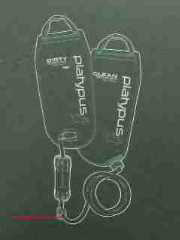
Several companies make gravity-operated "bag-type" water purifiers that clean water using a combination of one or more plastic bags, a filter, and plastic tubing. Some of these systems, such as the Platypus™ "Cleanstream" gravity water filter can produce water more rapidly and with less physical effort than a pump-type water filter.
The Cleanstream by Platypus produces 4 liters of filtered water in about 2.5 minutes, and weighs 12.7 oz. This product filters particles down to 0.2 microns, small enough to remove nearly all bacteria and protozoa that may contaminate a water supply.
The filter is good for 1500 liters of water - but presumably less than that total quantity, possibly much less, for water that is very contaminated or plain dirty. Platypus points out that the Cleanstream water filter system is not suitable for use in freezing conditions.
Reverse Osmosis for Water Purification in an Emergency
Reverse osmosis
also removes most contaminants from water; however in an emergency where public water supplies and/or electrical power are not provided, we do not assume that a home or building reverse osmosis system will be functional. If, however, the building has water pressure, a RO system will work just fine since normally these systems use only water pressure to operate the filter system.
Locate the RO system in the building and follow the water piping leaving that device so that you are sure to take drinking water only from fixtures that are supplied with treated water. Even in this case, if the building water piping downstream from the RO system has been flooded it will be unsanitary and is likely to need disinfection before water taken through that piping can safely be consumed.
See REVERSE OSMOSIS WATER TREATMENT for photographs of what RO equipment looks like and other details about that water treatment method.
Portable reverse osmosis water treatment equipment is available from companies such as Crystal Clear Supply.
Portable Silver Ceramic Water Purifiers
Silver ceramic water filters
are ceramic water filters which have been treated with colloidal silver - a step which increases filter effectiveness by killing bacteria in water passing through the system.
Watch out: not all colloidal silver treated filters are effective. Take a look at the water treatment effectiveness discussion where COLLOIDAL SILVER for WATER DISINFECTION is used.
Sink Cartridge Type Water Filters as Water Purifiers in an Emergency
Sink cartridge water filters:
We would not rely on the smaller store-bought filter cartridges that are simply attached to the tip of a kitchen sink faucet without clear documentation about just what that filter cartridge can remove from water, and how many of gallons of water it can process before it is exhausted.
Watch out: It would be unsafe to continue to "purify" water through an exhausted cartridge like filter.
In contrast,CERAMIC FILTERS for WATER DISINFECTION for water as well as some more recent single or multi-stage microfiber water filters have a very high gallon capacity and most models can simply be cleaned and re-used.
Guide to Portable UV Lights for Emergency Water Purification
Portable UV Light Sterilizers for Emergency Drinking Water - the SteriPen®
The SteriPen® Classic is a portable UV water purifier that can treat a liter of water, using ultraviolet light, in 1 1/2 minutes. The manufacturer informs consumers that UV light destroys viruses, bacteria, and protozoa. The microbes covered by this description include Cryptosporidium, viruses, bacteria, and Giardia, and also E. coli, Salmonella, Staph, and Strep.
The SteriPen® works by combining a battery-operated UV light combined with a mixing wand that is inserted into a container of water. The SteriPen weighs 5.7 oz, and as you can see even in our package photo, it is quite compact.
To operate the SteriPen® the user uses a slide switch to select the volume of water to be treated and to turn on the device. The UV lamp-end of the Steri-Pen is inserted downwards into "clear water" (see our warnings below), and the water is stirred until the indicator light (basically a timer) turns green.
Watch out: Factors that affect the effectiveness and operating time of any UV light used to treat water in an effort to make it potable, or at least improve its potability include at least the following:
- What contaminants are present in the water. UV treatment does not address chemical contaminants, nor do some water filters.
- The water temperature. (The SteriPen includes a temperature sensor)
- The water clarity.
As we discuss in more detail at UV ULTRAVIOLET LIGHT WATER TREATMENT, the proper UV light selection for water treatment is critical in the success of this approach.
The UV light must have been properly selected to handle the volume and flow rate of the water supply where it is installed. If ultra violet light is not of sufficient capacity to treat water flowing past its bulb it will not be effective. Therefore it is important to follow the manufacturer's instructions when using the SteriPen UV light portable device.
UV Light & Giardia:
Although the SteriPen producers describe this device as handling Giardia in water, not all sources agree that UV light will reliably and effectively kill cysts. -- [Dr. Omar Amin, of the Tempe AZ Parasitology Center]. Websites that advertise use of UV light to kill giardia may be misleading. UV light will kill Giardia trophozoites but the real concern for drinking water is the cysts, since it is the cysts from stool that appear there. Other treatment methods may be needed if Giardia is present in the water supply.
UV light for water disinfection where Giardia is present has, however, been successfully used in combination with chlorination as an approach to killing Giardia in water.
Watch out: OPINION: if the water you are treating is visibly dirty or murky, there is a significant risk that the UV light will not penetrate and act on microorganisms in the water nearly as rapidly, and additional pre-filtering steps and/or extended treatment time may be necessary.
Permanently-Installed UV Lights Installed on Private Well Water Systems
UV Lights for water purification:
UV Lights are not filters. UV lights for drinking water treatment are installed in some properties as a means to kill bacteria in a water supply.
We do not anticipate that UV light systems will be working in a disaster area, and we are doubtful that one can rely on this process for emergency drinking water purification: even if a UV light system is working, it will at kill bacteria and similar pathogens only.
But if emergency generators or emergency electrical power are being provided to run a local water pump intended to provide drinking water, be sure that power is also provided to the UV light or to any other water treatment equipment that is installed in your location.
Watch out: OPINION: if the emergency event that has led to loss of power and water included a severe storm or flooding or other event that has sent ground water or flood waters into a private well, that water may be contaminated with chemicals or other ingredients that were never anticipated by water treatment equipment already installed at a building.
Therefore even if you return a private well and water treatment equipment to operation, the water may not be safe to drink. Seek advice from local emergency management authorities before drinking water from any water source following an emergency, and to be safe, until you get an "OK" on using local water sources, you'll want to rely on suitable portable water purification methods.
A UV light water treatment system will not remove chemical contaminants in a water supply.
See UV ULTRAVIOLET LIGHT WATER TREATMENT for details of residential type UV light water treatment systems as well as a discussion of when such systems are useful and appropriate.
UV Light & Giardia:
UV light does not kill cysts, according to Dr. Amin. Websites that advertise use of UV light to kill giardia may be misleading. UV light will kill Giardia trophozoites but the real concern for drinking water is the cysts, since it is the cysts from stool that appear there. Other treatment methods may be needed if Giardia is present in the water supply.
UV light for water disinfection where Giardia is present has, however, been successfully used in combination with chlorination as an approach to killing Giardia in water.
...
Continue reading at GIARDIA in DRINKING WATER or select a topic from the closely-related articles below, or see the complete ARTICLE INDEX.
Or see these
Recommended Articles
- CERAMIC FILTERS for WATER DISINFECTION
- DRINKING WATER EMERGENCY PURIFICATION and also see DRINKING WATER EMERGENCY SOURCES
- REVERSE OSMOSIS WATER TREATMENT
- WATER FILTERS, HOME USE information on home water filters to be installed on plumbing systems in regular use, such as filters used to remove dirt, silt, sediment, iron, and odors from well water
- WATER FILTERS - SEDIMENT & IRON
- WATER TREATMENT EQUIPMENT CHOICES
Suggested citation for this web page
FILTERS for DRINKING WATER PURIFICATION at InspectApedia.com - online encyclopedia of building & environmental inspection, testing, diagnosis, repair, & problem prevention advice.
Or see this
INDEX to RELATED ARTICLES: ARTICLE INDEX to WATER TREATMENT SYSTEMS
Or use the SEARCH BOX found below to Ask a Question or Search InspectApedia
Ask a Question or Search InspectApedia
Try the search box just below, or if you prefer, post a question or comment in the Comments box below and we will respond promptly.
Search the InspectApedia website
Note: appearance of your Comment below may be delayed: if your comment contains an image, photograph, web link, or text that looks to the software as if it might be a web link, your posting will appear after it has been approved by a moderator. Apologies for the delay.
Only one image can be added per comment but you can post as many comments, and therefore images, as you like.
You will not receive a notification when a response to your question has been posted.
Please bookmark this page to make it easy for you to check back for our response.
Our Comment Box is provided by Countable Web Productions countable.ca
Citations & References
In addition to any citations in the article above, a full list is available on request.
- [1] Preliminary Assessment of Suspected Carcinogens in Drinking Water, Interim Report to Congress, U.S. Environmental Protection Agency, 1975, web search 10/06/2011, original source: U.S. EPA http://nepis.epa.gov
- [2] Ambient Water Quality Criteria for 2,4-dichlorophenol, U.S. EPA, Office of Water Regulations & Standards, Criteria & Standards Division, Washington D.C., USA, EPA 440, 5-80-042 October 1980
- Mark Cramer Inspection Services Mark Cramer, Tampa Florida, Mr. Cramer is a past president of ASHI, the American Society of Home Inspectors and is a Florida home inspector and home inspection educator. (727) 595-4211 mark@BestTampaInspector.com 11/06
- Hankey and Brown home inspectors, Eden Prairie, MN, technical review by Roger Hankey, prior chairman, Standards Committee, American Society of Home Inspectors - ASHI. 952 829-0044 - hankeyandbrown.com 11/06
- Dr. Omar Amin, of the Tempe AZ Parasitology Center, corresponded with one of our readers asking about peroxide: "You can use hydrogen peroxide if you want to but we do not have a track record of percentage dilution". Dr. Amin has done research for the US military and for the CDC.
- Aquamira™ chlorine dioxide water purification kits - see www.aquamira.com/
"Aquamira Water Treatment Drops were introduced to the Outdoor market in 1999 and have been a favorite of top outdoor guides and instructors ever since. Whether you are camping, traveling in a foreign country or faced with a disaster, our goal is to provide you with safe, pure and good tasting drinking water. Our complete line of water treatment products include leading edge purification and filtration technologies developed and tested in the lab and proven in the field. We offer systems and products that will provide water for a single individual or a village and almost anything in between." - Cascade Designs, Inc., 4000 1st Avenue South Seattle, WA 98134 U.S.A., Tel: 1-206-505-9500, Email: consumer@cascadedesigns.com, is the parent company of MSR, producing water treatment and other camping equipment.
- Katadyn™, a Swiss corporation provides water filters, desalinization equipment, and their Micropur chlorine dioxide water purification - see www.katadyn.com/usen/
"Katadyn offers a wide variety of water filtration and purification products suitable for any need. This allows outdoor enthusiasts and travelers to take along products for making their own drinking water when preparing their trips." - Potable Aqua® emergency drinking water germicidal tablets are produced by the Wisconsin Pharmacal Co., Jackson WI 53037. 800-558-6614 pharmacalway.com
- "Bacteria in Drinking Water" - "Chlorine," Karen Mancl, water quality specialist, Agricultural Engineering, Ohio State University Extension. Mancl explains factors affecting the effectiveness of chlorine in water as a means to destroy bacteria and other microorganisms. OSU reports as follows:
Chlorine kills bacteria, including disease-causing organisms and the nuisance organism, iron bacteria. However, low levels of chlorine, normally used to disinfect water, are not an effective treatment for giardia cysts. A chlorine level of over 10 mg/1 must be maintained for at least 30 minutes to kill giardia cysts. -- http://ohioline.osu.edu/b795/index.html is the front page of this bulletin.
- Crystal Clear Supply provides portable ceramic water filter purifiers and portable reverse osmosis water treatment equipment - see http://www.crystalclearsupply.com/category_s/7.htm
- "Do Iodine Water Purification Tablets Provide an Effective Barrier against Cryptosporidium parvum?", Starke, Jeffrey A., Bowman, Dwight D., Labare, Michael, Fogarty, Elizabeth A., and others, Military Medicine, 25 October 2001 [possibly a later version of this article appeared in 2005 -DF] http://www.amsus.org/military medicine/milmed.htm
- " Drinking Water Safety in Emergencies ", University of Minnesota extension, extension.umn.edu/info-u/nutrition/BJ646.html
- FDA Warning about drinking hydrogen peroxide: www.truthorfiction.com/rumors/h/hydrogen-peroxide.htm This article cites a 2003 entry in Journal of Food and Science on using Hy.Perox to sterilize vegetables, referring to E.coli - NOT to Giardia.
- www.epa.gov/ogwdw/mdbp/pdf/alter/chapt_2.pdf provides an article on use of disinfectants for water treatment
- This patent application for UV light sterilization www.patentstorm.us/patents/6565803.html Lists good references on water purification for Giardia et als
- GIARDIA in DRINKING WATER exposure limits for drinking water: see www.mass.gov/dep/water/drinking/standards/giardia.htm is the current regulatory exposure limit (your minimum target for sterilization)
- Wikipedia on history of use of hydrogen peroxide: Information on Hydrogen peroxide as a sterilant is in Wikipedia at en.wikipedia.org/wiki/Sterilization_(microbiology) HO2 has been used for a long time, including by vaporization for sterilizing freeze dryers.
- Platypus water filters such as the Cascade bag type water filter are produced by Cascade Designs, Inc., 4000 First Ave. South, Seattle WA 98134, USA, Tel: 1-800-531-9531
- Potable Aqua® emergency drinking water germicidal tablets are produced by the Wisconsin Pharmacal Co., Jackson WI 53037. 800-558-6614 pharmacalway.com
- Principles and Practice of Disinfection, Preservation and Sterilization (Hardcover)
by A. D. Russell (Editor), W. B. Hugo (Editor), G. A. J. Ayliffe (Editor), Blackwell Science, 2004. ISBN-10: 1405101997, ISBN-13: 978-1405101998.
"This superb book is the best of its kind available and one that will undoubtedly be useful, if not essential, to workers in a variety of industries. Thirty-one distinguished specialists deal comprehensively with the subject matter indicated by the title ... The book is produced with care, is very readable with useful selected references at the end of each chapter and an excellent index. It is an essential source book for everyone interested in this field. For pharmacy undergraduates, it will complement the excellent text on pharmaceutical microbiology by two of the present editors."
The Pharmaceutical Journal: "This is an excellent book. It deals comprehensively and authoritatively with its subject with contributions from 31 distinguished specialists. There is a great deal to interest all those involved in hospital infection ... This book is exceptionally well laid out. There are well chosen references for each chapter and an excellent index. It is highly recommended." The Journal of Hospital Infection.: "The editors and authors must be congratulated for this excellent treatise on nonantibiotic antimicrobial measures in hospitals and industry ... The publication is highly recommended to hospital and research personnel, especially to clinical microbiologists, infection-control and environmental-safety specialists, pharmacists, and dieticians."
New England Journal of Medicine: City Hospital, Birmingham, UK. Covers the many methods of the elimination or prevention of microbial growth. Provides an historical overview, descriptions of the types of antimicrobial agents, factors affecting efficacy, evaluation methods, and types of resistance. Features sterilization methods, and more. Previous edition: c1999. DNLM: Sterilization--methods. - Handbook of Disinfectants and Antiseptics, Joseph M. Ascenzi (Editor), CRC, 1995, ISBN-10: 0824795245 ISBN-13: 978-0824795245 "The evaluation of chemical germicides predates the golden age of microbiology..." -
This well-focused, up-to-date reference details the current medical uses of antiseptics and disinfectants -- particularly in the control of hospital-acquired infections -- presenting methods for evaluating products to obtain regulatory approval and examining chemical, physical, and microbiological properties as well as the toxicology of the most widely used commercial chemicals. - When Technology Fails, Matthew Stein, Chelsea Green Publisher, 2008,493 pages. ISBN-10: 1933392452 ISBN-13: 978-1933392455, "... how to find and sterilize water in the face of utility failure, as well as practical information for dealing with water-quality issues even when the public tap water is still flowing". Mr. Stein's website is www.whentechfails.com/
- "Bacteria in Drinking Water" - "Chlorine," Karen Mancl, water quality specialist, Agricultural Engineering, Ohio State University Extension. Mancl explains factors affecting the effectiveness of chlorine in water as a means to destroy bacteria and other microorganisms. OSU reports as follows:
Chlorine kills bacteria, including disease-causing organisms and the nuisance organism, iron bacteria. However, low levels of chlorine, normally used to disinfect water, are not an effective treatment for giardia cysts. A chlorine level of over 10 mg/1 must be maintained for at least 30 minutes to kill giardia cysts. -- http://ohioline.osu.edu/b795/index.html is the front page of this bulletin.
- Ohio State University article on the concentration of chlorine necessary to act as an effective disinfectant, and the effects of the water's pH and temperature: See http://ohioline.osu.edu/b795/b795_7.html for details.
- Extreme Lead Poisoning Symptoms Suggested by Feb 2006 NY Times Article on Kosovo Roma Camps
- Our recommended books about building & mechanical systems design, inspection, problem diagnosis, and repair, and about indoor environment and IAQ testing, diagnosis, and cleanup are at the InspectAPedia Bookstore. Also see our Book Reviews - InspectAPedia.
- In addition to citations & references found in this article, see the research citations given at the end of the related articles found at our suggested
CONTINUE READING or RECOMMENDED ARTICLES.
- Carson, Dunlop & Associates Ltd., 120 Carlton Street Suite 407, Toronto ON M5A 4K2. Tel: (416) 964-9415 1-800-268-7070 Email: info@carsondunlop.com. Alan Carson is a past president of ASHI, the American Society of Home Inspectors.
Thanks to Alan Carson and Bob Dunlop, for permission for InspectAPedia to use text excerpts from The HOME REFERENCE BOOK - the Encyclopedia of Homes and to use illustrations from The ILLUSTRATED HOME .
Carson Dunlop Associates provides extensive home inspection education and report writing material. In gratitude we provide links to tsome Carson Dunlop Associates products and services.


